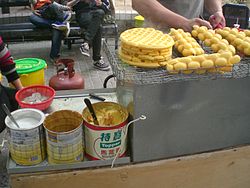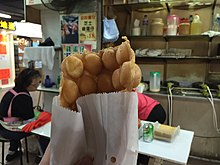 Small ball-shaped egg waffle and large European-style waffles at a street food stand | |
| Alternative names | Bubble Waffle, Egg puff, puffle, gai daan jai, egglet |
|---|---|
| Type | Pancake or waffle |
| Place of origin | Hong Kong |
| Serving temperature | Hot |
| Main ingredients | Eggs, sugar, flour, evaporated milk |
| Egg waffle | |||||||||||||
|---|---|---|---|---|---|---|---|---|---|---|---|---|---|
 | |||||||||||||
| Traditional Chinese | 雞蛋仔 | ||||||||||||
| Simplified Chinese | 鸡蛋仔 | ||||||||||||
| Jyutping | Gai1 daan6 zai2 | ||||||||||||
| Literal meaning | Chicken egg + [diminutive suffix] | ||||||||||||
| |||||||||||||
An egg waffle is a spherical egg-based waffle popular in Hong Kong and Macau, [1] consisting of an eggy leavened batter cooked between two plates of semi-spherical cells. They are usually served hot,and often eaten plain,although they may be served with fruit and flavors such as strawberry,coconut,or chocolate. [2] It is referred to by its original Cantonese name,gai daan jai (雞蛋仔), [1] and in English,an egg puff,bubble waffle,eggette,pancake balls,pancake waffle,egglet,and puffle.[ citation needed ] They are sometimes referred to as Hong Kong cakes in Chinatowns across America,especially in New York. [3] One piece of egg waffle can have around 20 to 35 small round 'balls'.
Contents
Egg waffles are among the most popular Hong Kong "street snacks" and were ranked No. 1 in a 100 most popular HK street snack listing. [4] They have been a favored street snack since their emergence in the 1950s,when they were made with coal fire heating and sold from street kiosks in Hong Kong. [5] [6] [7]

